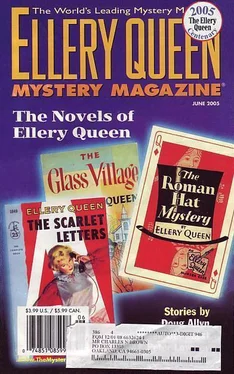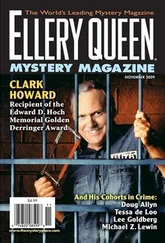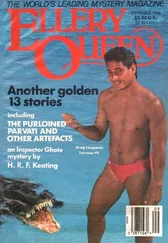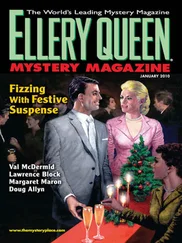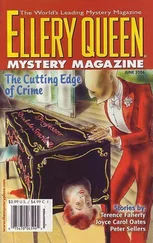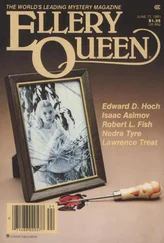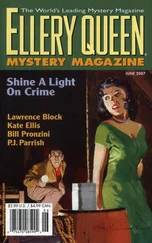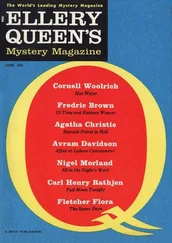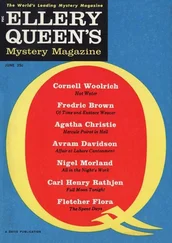Doug Allyn - Ellery Queen’s Mystery Magazine. Vol. 125, No. 6. Whole No. 766, June 2005
Здесь есть возможность читать онлайн «Doug Allyn - Ellery Queen’s Mystery Magazine. Vol. 125, No. 6. Whole No. 766, June 2005» весь текст электронной книги совершенно бесплатно (целиком полную версию без сокращений). В некоторых случаях можно слушать аудио, скачать через торрент в формате fb2 и присутствует краткое содержание. Город: New York, Год выпуска: 2005, ISBN: 2005, Издательство: Dell Magazines, Жанр: Детектив, на английском языке. Описание произведения, (предисловие) а так же отзывы посетителей доступны на портале библиотеки ЛибКат.
- Название:Ellery Queen’s Mystery Magazine. Vol. 125, No. 6. Whole No. 766, June 2005
- Автор:
- Издательство:Dell Magazines
- Жанр:
- Год:2005
- Город:New York
- ISBN:ISSN 1054-8122
- Рейтинг книги:3 / 5. Голосов: 1
-
Избранное:Добавить в избранное
- Отзывы:
-
Ваша оценка:
- 60
- 1
- 2
- 3
- 4
- 5
Ellery Queen’s Mystery Magazine. Vol. 125, No. 6. Whole No. 766, June 2005: краткое содержание, описание и аннотация
Предлагаем к чтению аннотацию, описание, краткое содержание или предисловие (зависит от того, что написал сам автор книги «Ellery Queen’s Mystery Magazine. Vol. 125, No. 6. Whole No. 766, June 2005»). Если вы не нашли необходимую информацию о книге — напишите в комментариях, мы постараемся отыскать её.
Ellery Queen’s Mystery Magazine. Vol. 125, No. 6. Whole No. 766, June 2005 — читать онлайн бесплатно полную книгу (весь текст) целиком
Ниже представлен текст книги, разбитый по страницам. Система сохранения места последней прочитанной страницы, позволяет с удобством читать онлайн бесплатно книгу «Ellery Queen’s Mystery Magazine. Vol. 125, No. 6. Whole No. 766, June 2005», без необходимости каждый раз заново искать на чём Вы остановились. Поставьте закладку, и сможете в любой момент перейти на страницу, на которой закончили чтение.
Интервал:
Закладка:
The Chinese Orange Mystery, published in 1934, is still remembered fondly by many readers for its bizarre crime scene. The year also saw publication of The Adventures of Ellery Queen, a collection of outstanding short stories which had appeared in various magazines. The best of these, and the most often reprinted, is “The Mad Tea Party.” The final book in Queen’s early period was The Spanish Cape Mystery in 1935. The novel opens with a kidnapping and, later, the discovery of a naked corpse on a secluded beach. Once again the solution is a surprise.
The next five novels in the Queen canon, influenced by the demands of slick magazines (in which some of them were serialized), show a distinct movement away from the complex plots and pure deduction of the earlier Queens. Some consider these five to be among the poorest early Queens, but they should not be dismissed too readily. Halfway House, published in 1936, is really a transition novel and still included some of the best deduction features from the earliest period. Its story of a man who lived two lives and was murdered in a limbo between his two identities is quite clever. And 1937’s The Door Between is a locked-room mystery with a startling double solution. The Hollywood settings of the next two novels, The Devil to Pay and The Four of Hearts, seem somehow to be the wrong milieu for Ellery, and in The Dragon’s Teeth Ellery himself is absent from too much of the action, yielding the scene to a charming imposter.
The high point of this second period was undoubtedly the publication of a second short-story collection, The New Adventures of Ellery Queen, in 1940. Especially notable was a short novel, “The Lamp of God,” in which an entire house is made to disappear without a trace. The collection also includes four sports mysteries, notably the boxing story “Mind Over Matter.”
It was 1942 before the next Queen novel, Calamity Town, appeared. It was worth the wait, and by general critical consensus is one of the two best novels Ellery Queen ever wrote. In this book Ellery abandons the crowded environs of Manhattan and Hollywood for the more relaxed pace of Wrightsville, a small New England town which was to have more than its share of murders in the years that followed. The characterizations in Calamity Town are more rounded, the writing is at its peak, and the novel has a depth lacking in much crime fiction. Ellery, seeking peace and quiet, is drawn into the mystery when murder occurs at a New Year’s party. All the principal events of the book take place on holidays, and Ellery finally arrives at the tragic solution on Mother’s Day.
There Was an Old Woman, published the following year, marks a brief return to the older Queen style, with nursery-rhyme allusions reminiscent of “The Mad Tea Party.” The idea of murder during a duel with pistols is an interesting one, the characters are suitably wacky, and the double solution is satisfying, but the book is not one of the major Queen efforts.
In 1945 Ellery returned to Wrightsville in The Murderer Is a Fox, an underrated novel that has much to recommend it. Here the puzzle involves a twelve-year-old poisoning which Ellery must reconstruct and solve. He does so, brilliantly, using once again a false solution followed by the real one.
In 1948 came Ten Days’ Wonder, a major Queen novel and one that continued to attract the attention of critics and filmmakers thirty years after its publication. The religious overtones in this novel are stronger than in any previous Queen book. Again Ellery is in Wrightsville, involved with Diedrich Van Horn, his young wife, and his adopted son. Though the cast is small the book is full of surprises, and includes a double solution. It is, truly, a rich cosmic drama, and a book that has gained in stature with the passing decades. It is not too bold to suggest that future generations might come to regard it as Queen’s finest achievement in the novel.
Ellery himself was near despair in the final pages of Ten Days’ Wonder, and Cat of Many Tails, published the following year, is a direct sequel. Still questioning his abilities, he is called upon to discover the identity of a Ripper-like strangler who is killing people, apparently at random, on the streets of New York. It is Queen’s longest postwar novel and his richest. The portrait of New York in the grip of near hysteria has never been bettered, and the hunt for a killer known only as the Cat is intriguing all the way. The motive, and thus the pattern the killings follow, is one of the cleverest in mystery fiction, and the apparent capture of the Cat, using a young woman decoy, is perhaps the most suspenseful scene in any Queen novel. Once again a second, true solution follows the first, leaving Ellery with further doubts about his reasoning powers. Critics generally agree that Cat of Many Tails and Calamity Town are the two best Queen novels.
After this high point Ellery returned to Wrightsville in 1950’s Double, Double. Here a series of killings seems to follow a children’s rhyme (“Rich man, poor man”). The final solution, after another false one, is satisfying — though a variation had been used in an earlier novel. It is not the equal of the three previous Wrightsville books, though still a distinctively Queenly novel.
The 1951 Queen novel was The Origin of Evil, which echoes some elements from previous books. Here again the killings are preceded by enigmatic gifts, and the motive lies in the past. Ellery returns to Hollywood in this novel, and it is far more successful than his previous outings there.
The first of Queen’s two 1952 books was another short-story collection, Calendar of Crime, with each story revolving around an event associated with a month of the year. All the stories grew out of scripts Dannay and Lee wrote for the Ellery Queen radio series, and two of them, “The Gettysburg Bugle” and “The Dauphin’s Doll,” are among Queen’s best. The 1952 novel was The King Is Dead, a clever locked-room mystery set on the mythical island kingdom of a weapons tycoon. It is Queen’s closest attempt at a political thriller, but the plot — complete with a scene back in Wrightsville — seems closer to fable than reality.
The Scarlet Letters, an enjoyable Manhattan romp that follows a blackmail plot to twenty-six New York locations keyed to letters of the alphabet, followed in 1953. The murder and solution, bunched together near the end of the book, provide a plot more suitable for a short story than a novel. But the book is fun to read and gives us our best novel-length portrait of Ellery’s secretary Nikki Porter.
In 1954 Queen produced something entirely different, a novel with serious overtones about American life in the 1950s — and the threat of McCarthyism — which also happened to be a first-rate detective story. The Glass Village was Queen’s first novel without Ellery or any other series character, and its plot involved a foreign-looking tramp accused of murdering an elderly primitive painter. Johnny Shinn, a returned veteran whose uncle is a judge, solves the mystery in a New England town. Dannay and Lee hoped to attract attention by lifting the book out of the regular Ellery Queen series, but in truth the detective could have been Ellery and the setting could have been Wrightsville. In fact, the novel was dramatized in an Ellery Queen television series with Ellery as the detective.
The year 1955 saw publication of another short-story volume, QBI: Queen’s Bureau of Investigation, including “Snowball in July” and other excellent tales. In Inspector Queen’s Own Case, published the following year, Ellery is again missing, while his father, retired from the police force, falls in love and solves a mystery involving the murder of a two-month-old baby. Since most of the suspects are older people, the contrast with the extreme youth of the victim is striking. The book has much to say about ageing, suggesting that the Queen canon might be drawing to an end. Indeed, Queen’s 1958 novel The Finishing Stroke showed every sign of being his last, from its title to the intricate house-party murder set back in 1929 but not solved until the present. Again there is a series of bizarre gifts, and a neat twist about halfway through the book.
Читать дальшеИнтервал:
Закладка:
Похожие книги на «Ellery Queen’s Mystery Magazine. Vol. 125, No. 6. Whole No. 766, June 2005»
Представляем Вашему вниманию похожие книги на «Ellery Queen’s Mystery Magazine. Vol. 125, No. 6. Whole No. 766, June 2005» списком для выбора. Мы отобрали схожую по названию и смыслу литературу в надежде предоставить читателям больше вариантов отыскать новые, интересные, ещё непрочитанные произведения.
Обсуждение, отзывы о книге «Ellery Queen’s Mystery Magazine. Vol. 125, No. 6. Whole No. 766, June 2005» и просто собственные мнения читателей. Оставьте ваши комментарии, напишите, что Вы думаете о произведении, его смысле или главных героях. Укажите что конкретно понравилось, а что нет, и почему Вы так считаете.
